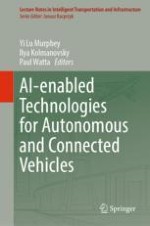2023 | OriginalPaper | Buchkapitel
Robust AI Driving Strategy for Autonomous Vehicles
verfasst von : Subramanya Nageshrao, Yousaf Rahman, Vladimir Ivanovic, Mrdjan Jankovic, Eric Tseng, Michael Hafner, Dimitar Filev
Erschienen in: AI-enabled Technologies for Autonomous and Connected Vehicles
Aktivieren Sie unsere intelligente Suche, um passende Fachinhalte oder Patente zu finden.
Wählen Sie Textabschnitte aus um mit Künstlicher Intelligenz passenden Patente zu finden. powered by
Markieren Sie Textabschnitte, um KI-gestützt weitere passende Inhalte zu finden. powered by
